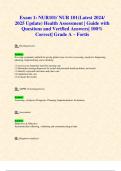Exam 1: NUR101/ NUR 101(Latest 2024/
2025 Update) Health Assessment | Guide with
Questions and Verified Answers| 100%
Correct| Grade A – Fortis
Q: Nursing process
Answer:
five-step systematic method for giving patient care; involves assessing, (analysis) diagnosing,
planning, implementing, and evaluating
(1) assess pt to determine need for nursing care
(2) determine nursing diagnoses for actual and potential health problems and needs
(3) identify expected outcomes and place care
(4) implement the care
(5) evaluate the results
Q: ADPIE of nursing process
Answer:
Assessing, (Analysis) Diagnosis, Planning, Implementation, Evaluation
Q: Assessment
Answer:
Subjective & Objective
Systematically collecting, validating and communicating pt data
Q: Diagnosis (analysis)
,Answer:
Nursing diagnosis
Clearly identify pt strengths and actual and potential health problems and needs
Q: Planning
Answer:
Goals — "SMART; specific, measurable, attainable, realistic, time based (pt-centered)"
Develop a holistic plan of individualized care that specifies the desired pt goals and related
outcomes and the nursing interventions most likely to assist the pt to meet those expected
outcomes
Q: Implementation/intervention
Answer:
Execute the plan of care
Q: Evaluation
Answer:
Pt response
Evaluate effectiveness of plan of care in terms of pt goal achievement
Q: Purpose of nursing observation, interview, and physical assessment
Answer:
Appraisal of health status
Identification of health problems
Establishment of a database for nursing interventions
Q: How to obtain nursing history using effective interviewing techniques
,Answer:
All interviews should begin with an explanation of the purpose of the interview
Open-ended questions or comments—prevents simple yes or no answers
Closed question or comment—answered by one or two words, yes or no; used to gather specific
information from a pt to focus on a particular area
Validating question or comment—overusing validating questions or comments can lead to a pt
thinking the nurse is not listening
Clarifying questions or comments—allows nurse to gain understanding of pts comment; can
prevent misconceptions that could lead to identification of an inappropriate diagnosis or pt
problem
Reflective question or comment—encourages pt to elaborate
Sequencing question or comment—places events in chronological order or to investigate
possible cause-and-effect relationship btw events
Directing question or comment—going back to a topic brought up earlier in interview or to
introduce new aspect of current topic
Q: Prioritizing assessments and collecting data systematically
Answer:
ABCs (or ABCDE): airway, breathing, circulation, disability, exposure
Pt needs—emergent or not
Maslows Hierarchy of needs
Q: 4 Phases of nursing interview
Answer:
Study preparatory, introduction, working, and termination phase
, Q: Study preparatory
Answer:
Pre-interaction, collects background info in the chart
Q: Introduction
Answer:
Orientation, introduce self, purpose, process, expectations, duration
Q: Working
Answer:
interview, proper client centered discussion, therapeutic communication techniques
Q: Termination phase
Answer:
Closing, summarize, clarify, validate, answer questions, set follow-up appointments
Q: Common problem encountered in data collection
Answer:
Inappropriate organization of the database
Omission of pertinent data
Inclusion of irrelevant or duplicate data, erroneous or misinterpreted data
Failure to establish rapport and partnership
Recording an interpretation of data rather than observed behavior
Failure to update database




